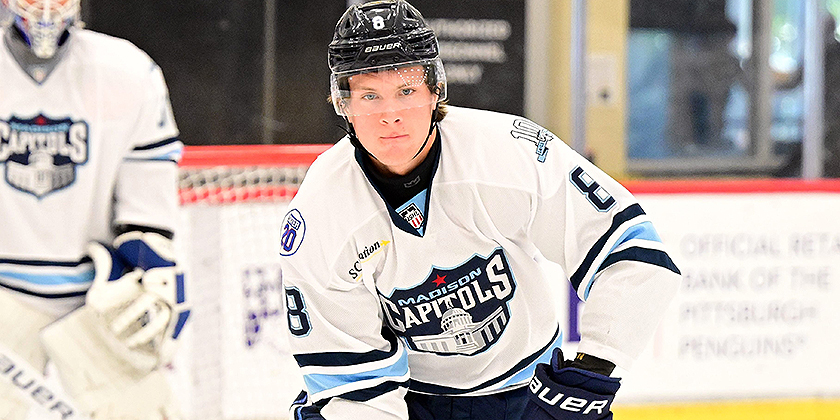
Sam Kappell (C, R, 6’1″, 190, Madison Capitols, 02/05/2007, Minnesota State)
Case for Sam Kappell as an NHL Draft Pick
Good Size and Strength
At 6’1″, 190 lbs, Kappell possesses an NHL projectable frame.
Uses size well to shield the puck and establish a net-front presence, creating second-chance opportunities.
Wins 54% of his 50/50 puck battles, showing solid competitiveness and strength in tight areas.
High Situational Awareness and IQ
Strong positioning in all three zones; finds open ice and plays a structured, detail-oriented game.
Effective net-front presence—disrupts sightlines and generates scoring chances through rebounds and screens.
Reads play well and capitalizes on turnovers, making the most of his scoring chances.
Reliable Two-Way Game
+8 rating shows he is defensively responsible and positively impacts even-strength play.
Earns time on both the power play (0:36 per game) and penalty kill (0:47 per game), demonstrating versatility.
3 takeaways per game—actively disrupts plays and applies good defensive pressure.
Finishing Ability
19% conversion rate on Grade “A” scoring chances— he capitalizes well on his limited opportunities.
Doesn’t generate a ton of shots per game (1.09 shots on goal, 1.09 Grade “A” scoring chances per game), but when he does, he’s efficient.
Case Against Sam Kappell as an NHL Draft Pick
Limited Offensive Production and Low Shot Volume
9 goals, 11 assists, 20 points in 40 games—production is below what’s expected for an NHL prospect at the USHL level.
Attempts just 1.55 shots per game and only 1.09 on goal – he is not creating enough offense himself or driving the play into the offensive zone and towards the net.
0.25 shots blocked and 0.2 missed per game—not aggressive or deceptive enough in his shot selection.
Lack of Physicality and Engagement
0.16 hard hits per game—not nearly enough for a 6’1″ power forward looking to create space for himself and his linemates.
Receives more hits (0.7 per game) than he delivers – he isn’t initiating contact as often as he should.
Struggles with Puck Management
3.4 giveaways per game—is not an outlandish number until you realize he is playing 11:23 per game with 5:03 of that being in the offensive zone.
80% passing accuracy is too low, especially for a player who isn’t creating high-end offensive plays. Needs to improve decision-making under pressure.
Ice Time and Usage Concerns
Yes he is averaging 13:42 over his last ten game stretch but his season average is 11:23 total ice time per game – we understand the USHL is an older league but he is not trusted as a top-line or top-six forward.
Minimal power play (0:36) and penalty kill (0:47) deployment—he is not leaned on for special teams – coaches see him as a “young” player rather than a key contributor.
Final Verdict: Draftable or Not?
Borderline Draft Pick – Late-Round or Undrafted Free Agent Candidate
Why Draft Him?
Size and hockey IQ give him a solid foundation for a potential bottom-six NHL role.
Strong net-front presence and finishing ability in tight areas.
Competes well in 50/50 battles and has defensive responsibility.
Could be a good two-way, penalty-killing depth forward with more offensive development and more consistent physicality.
Why Not Draft Him?
Limited offensive upside—doesn’t generate enough shots or points to project as a scoring forward.
Needs to improve puck management and passing decisions.
Lack of physicality for his size is concerning—he needs to play heavier to maximize his impact.
Not trusted with major ice time or special teams usage with Madison, which raises questions about his role at higher levels.
Projection:
Best-Case NHL Upside: Bottom-six checking forward who can kill penalties and contribute in a depth role.
Most Likely Path:
Finishes USHL career → NCAA development (2-3 years) → AHL depth forward → Possible NHL call-up in a checking role.
Draft Range: 7th round – undrafted.
Conclusion:
Kappell has size, intelligence, and a projectable two-way game, but his lack of offensive production, physicality, and puck management issues limit his NHL upside. A team may take a late-round flyer on him (6th-7th round) based on his frame and defensive awareness, but he is more likely to be an undrafted free agent who develops in the NCAA and earns a pro contract based on improved offensive production and a more physically engaged game.
Photo credit: Dan Hickling/Hickling Images
